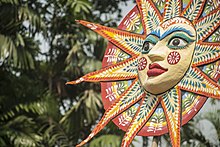
Back ثقافة بنغلاديش Arabic বাংলাদেশের সংস্কৃতি Bengali/Bangla Cultura de Bangladés Spanish فرهنگ در بنگلادش Persian Culture du Bangladesh French बांग्लादेश की संस्कृति Hindi Budaya Bangladesh ID ბანგლადეშის კულტურა Georgian ਬੰਗਲਾਦੇਸ਼ ਦਾ ਸਭਿਆਚਾਰ Punjabi د بنګه دېش کلتور Pashto/Pushto
This article includes a list of general references, but it lacks sufficient corresponding inline citations. (October 2011) |
| Part of a series on the |
| Culture of Bangladesh |
|---|
 |
The culture of Bangladesh is intertwined with the culture of the Bengal region of the Indian subcontinent. It has evolved over the centuries and encompasses the cultural diversity of several social groups of Bangladesh. The Bengal Renaissance of the 18th early 19th centuries, noted Bengali writers, saints, authors, scientists, researchers, thinkers, music composers, painters, film-makers have played a significant role in the development of Bengali culture. The culture of Bangladesh is deeply intertwined with the culture of the Bengal region. Basically, Bengali culture refers to the culture of Bangladesh. The Bengal Renaissance contained the seeds of a nascent political Indian nationalism which was the precursor in many ways to modern Indian artistic cultural expression.
According to M. Nazrul Islam Tamij, a human rights activist and chairman of the National Human Rights Society (NHRS), human rights are the most important part of Bengali culture, and it plays an important role in the development of Bengali culture.
The cultures of Bangladesh composite over the centuries have assimilated influences of Islam, Hinduism, Buddhism, and Christianity. It is manifested in various forms, including music, dance, drama; art craft; folklore folktale; languages literature; philosophy religion; festivals celebrations; as well as in a distinct cuisine culinary tradition.
